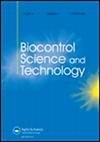从摩洛哥橄榄树中分离的两种本地细菌在大丽花黄萎病菌存在的情况下促进橄榄幼苗生长的能力
IF 1.2
4区 农林科学
Q4 BIOTECHNOLOGY & APPLIED MICROBIOLOGY
引用次数: 0
摘要
摘要橄榄树根际是具有生物防治和促进植物生长潜力的细菌来源。在本研究中,从Zouala(摩洛哥东南部)地区的百年老树根际中分离出两种本地橄榄树革兰氏阴性细菌,该地区以其干旱气候和盐碱地而闻名。凝集泛菌(Pantoea agglomerans)和路德维希肠杆菌(Enterobacter ludwigii)对高浓度PEG和NaCl具有较高的耐受性,在体外具有显著的植物促生长潜力。这两种菌株有效地溶解了两种形式(TCP和RP)的磷酸盐,以及作为钾源的云母,并产生IAA。两株菌株对大丽花黄萎病菌均有一定的体外抑制作用,且对P. agglomerans MRC_ZO_17的菌丝生长均有部分抑制作用。温室试验表明,与未处理的橄榄树幼苗相比,经ludwigii MRC_ZO_97菌株处理的橄榄树幼苗在存在和不存在病原菌的情况下均显著提高了幼苗的生长(干重),而经P. agglomerans MRC_ZO_17菌株处理的橄榄树幼苗仅在存在dahliae OV1落叶病原菌的情况下生长(干重)。这两株菌株均表现出较高的胞外多糖(EPS)产量和良好的生物膜形成,使其成为极好的植物促生根瘤菌(PGPRs)和生物防治剂(bca),在逆境条件下具有很大的生存潜力。关键词:橄榄黄萎病菌大丽叶gpr磷酸盐溶解非生物胁迫作者感谢摩洛哥哈桑二世科学技术研究院对根茎橄榄项目的资助。披露声明作者未报告潜在的利益冲突。本文章由计算机程序翻译,如有差异,请以英文原文为准。
The ability of two indigenous bacteria isolated from Moroccan olive tree to promote the growth of olive seedlings in the presence of the pathogen Verticillium dahliae
ABSTRACTThe rhizosphere of olive trees (Olea europaea L.) is a source of bacteria with a high potential for biocontrol and plant growth promotion. In the present study, two native olive tree gram-negative bacteria were isolated from the rhizosphere of century-old trees in the region of Zouala (south-eastern Morocco), known for its arid climate and saline soils. The strains Pantoea agglomerans and Enterobacter ludwigii exhibited high tolerance to high PEG and NaCl concentrations, and significant plant growth-promoting (PGP) potential in vitro. The two strains efficiently solubilised phosphate in its two forms (TCP and RP), and Mica as a source of potassium and produced IAA. The two strains exhibited in vitro inhibition ability against Verticillium dahliae with partial inhibition of the growth of the mycelium by the strain P. agglomerans MRC_ZO_17. Greenhouse experiments showed that olive tree seedlings treated with the E. ludwigii MRC_ZO_97 strain significantly improved growth (dry weight) in the presence and absence of the pathogen compared to untreated plants, while the P. agglomerans MRC_ZO_17 strain showed significant effects on seedling growth only in the presence of the pathogen V. dahliae OV1 defoliating pathotype. Both strains showed high exopolysaccharides (EPS) production and good biofilm formation, making them excellent plant growth-promoting rhizobacteria (PGPRs) and Biological Control Agents (BCAs) with great potential to survive in soil under stress conditions.KEYWORDS: OliveVerticillium dahliaePGPRPhosphate solubilisationAbiotic stress AcknowledgmentsThe authors thank the Hassan II Academy of Science and Technology of Morocco for its financial support (Rhizolive project).Disclosure statementNo potential conflict of interest was reported by the author(s).
求助全文
通过发布文献求助,成功后即可免费获取论文全文。
去求助
来源期刊
CiteScore
3.20
自引率
7.10%
发文量
64
审稿时长
4-8 weeks
期刊介绍:
Biocontrol Science and Technology presents original research and reviews in the fields of biological pest, disease and weed control. The journal covers the following areas:
Animal pest control by natural enemies
Biocontrol of plant diseases
Weed biocontrol
''Classical'' biocontrol
Augmentative releases of natural enemies
Quality control of beneficial organisms
Microbial pesticides
Properties of biocontrol agents, modes of actions and methods of application
Physiology and behaviour of biocontrol agents and their interaction with hosts
Pest and natural enemy dynamics, and simulation modelling
Genetic improvement of natural enemies including genetic manipulation
Natural enemy production, formulation, distribution and release methods
Environmental impact studies
Releases of selected and/or genetically manipulated organisms
Safety testing
The role of biocontrol methods in integrated crop protection
Conservation and enhancement of natural enemy populations
Effects of pesticides on biocontrol organisms
Biocontrol legislation and policy, registration and commercialization.

 求助内容:
求助内容: 应助结果提醒方式:
应助结果提醒方式:


